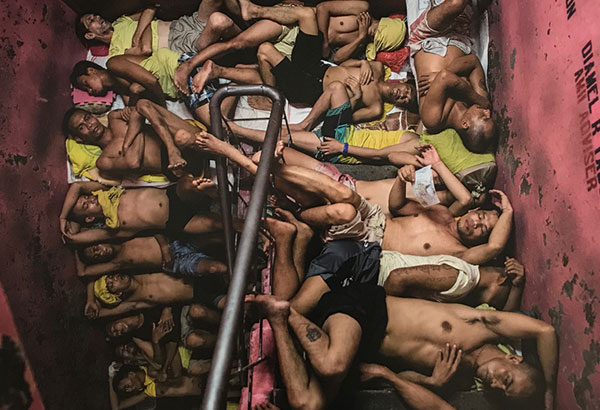ON ASSIGNMENT :The photographs that capture the world


Noel Celis' photograph of prisoners sleeping on a staircase inside the Quezon City Jail.
I burned my eyeballs out looking at too many paintings at the Louvre.
It’s not something someone typically says when they’ve been to the hallowed halls of one of the biggest houses of art in the world, but going through one gallery to the next — pictures of aristocrats, divinities, still lifes and the damn “Mona Lisa” in succession — every image tends to melt into the other, resulting in an unprocessed goo of light and color.
It might have been the attempt to cram every single thing in that 60,600 square meters of space into a mere few hours (it is recommended that you visit the museum over a span of days and in slight doses). It was a foolish attempt, I’ll admit, but by the time I reached the nth gift shop of the Louvre, I gave up.
One lonely day in Rome, a few days after the Louvre experience, I was happy to discover that the Palazzo delle Esposizioni in Rome wasn’t swimming in thousands of paintings. The sole exhibition focused on artist George Baselitz’s renderings of giant “heroes,” paced evenly, much to my eyeballs’ delight. But at the other end of the museum was a large space devoted to winners of the World Press Photo Contest 2017: stark, arresting photographs that served as windows into the events of 2016. It was, more than anything else, a more harrowing experience than anything I’d seen over the last few days of flitting through museum after museum.
The images were selected from over 80,000 entries by 5,034 photographers from 126 countries around the world. Categories span from contemporary issues, daily life, to nature. But it is obvious that the most pressing concerns come to the fore, revealing the increasing power of photography to document and witness the moments that shape our history.
There is a sense of urgency to each image. Even in the relative calm of a living room or a shot of traditional Korean garb hanging in someone’s bedroom, the wealth of stories that the photos reveal are underscored by an immediacy that unravels in the photograph’s rawness.
The first few images that you’ll see in the exhibit are from the Philippines — perhaps indirectly, a reminder of the real world to the tourist from Manila (i.e., me) who has gone far away to temporarily escape — Noel Celis’ photo of prisoners crammed in slumber on a staircase inside the Quezon City Jail; to its right are five of New York Times photojournalist Daniel Berehulak’s troubling specters from the war on drugs: a father’s body inside a casket, surrounded by his family, weeping; a room painted in pink, stacked with clothes, furniture and religious objects, shattered by the stark red of blood of one of its inhabitants, a gunshot victim.
Across the hall are hung Burhan Ozbilici’s photographs of the assassination of Andrey Karlov, the Russian ambassador to Turkey, shot by an off-duty police officer, Mevlut Mert Altintas, while the diplomat was speaking at an art gallery in Ankara. In the present setting of the exhibition, away from the pages of the dailies or a news website, the images take on a new meaning, a kind of parallelism that shatters the tenuous line between journalism and art.
“I was stunned and thought it was a theatrical flourish,” Ozbilici recounts in an AP article. “This is what I was thinking: ‘I’m here. Even if I get hit and injured, or killed, I’m a journalist. I have to do my work.’ I could run away without making any photos... but I wouldn’t have a proper answer if people later ask me, ‘Why didn’t you take pictures?’” he continues.
Elsewhere are worlds that we wouldn’t otherwise see. The long-term projects of Hossein Fatemi’s immersion in the subtle emergence of a modern Iran; Markus Jokela and his transcendent photos of the mundane life of a small, almost hermetic town of Table Rock, Nebraska; and Valery Melnikov’s hard look at the degradation of Ukraine from full-scale conflict.
Even more memorable are singular images: a shot of a woman’s legs wearing stockings, replete with runs, and with a folded bill tucked in one of the ripped seams; a line of little Chinese girls squatting against a wall, doing 30 minutes of toe-pressure exercises as part of their intense gymnastics training; and a girl, her face captured in an exact second of fear, standing outside as Iraqi special operations forces search her home in a suburb in Mosul, Iraq.
There is something about a photograph mounted on a wall, linked to a succession of moments, and permitted only a few words of description. We are used to seeing these press images blown up, accompanying tickertape bits, and thrown into the news cycle. But once the furor has passed, these images transform into something than just mere recording; they become an accumulation of moments that come loaded with the burden of history.
In different times, the takeaway might have been different. There might be assurance that the images would dissolve into the blur of history. But as today’s political climate becomes even more unwieldy, these photographs are tangible reminders of how our world is getting smaller and smaller; our existence lined by acts of aggression, erasure, and neglect.
* * *
The exhibition of the World Press Photo Contest is shown in over 100 cities worldwide. For listings, visit worldpressphoto.org.
Tweet the author @donutjaucian.















